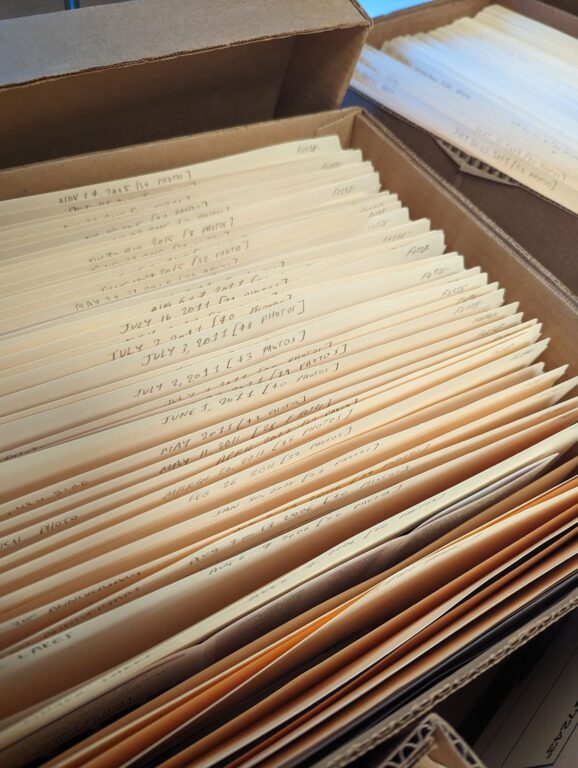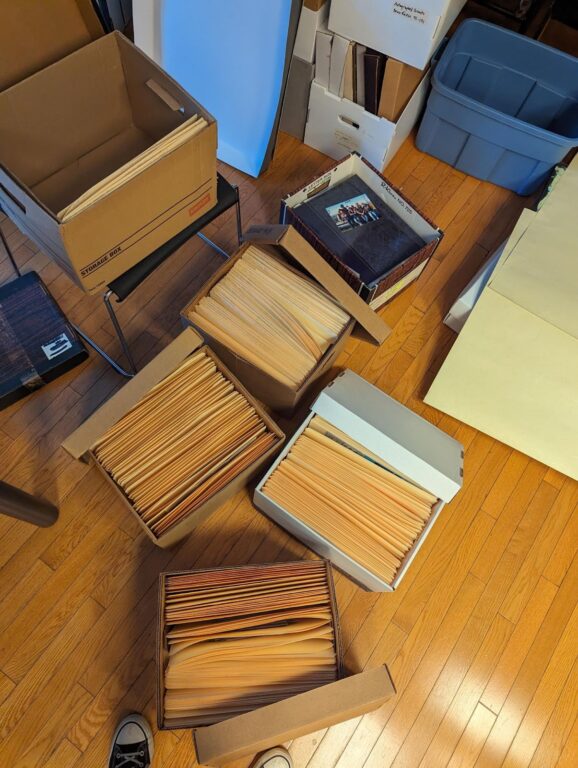My name is Lily Holland, and for 4 weeks this fall, I Interned at The ArQuives, and processed the Sue Wells fonds. As a PhD student based in Bristol, England, I was funded by the South West and Wales Doctoral Training Partnership to undertake this internship in order to learn more about queer and trans archiving, and assist The ArQuives with their important work.
The fonds I arranged and described was that of Sue Wells, pictured above.
Wells is someone who, prior to my arrival in Toronto, I had never heard of. If you don’t know who Sue is, she’s a queer activist and motorcyclist from Toronto, most notable for being a member of the Brunswick 4, and the founder and ‘Benevolent Dictator’ of the Amazons Motorcyle Club from 1978-present. You may have seen the Amazons leading Toronto Pride on their bikes, wearing their signature Amazons patches; the large majority of which were hand-sewn by Sue herself, taking 29 hours each. Pictured below is Sue’s vest, adorned with the second patch she ever made, in 1978.

The Amazons were started by Sue Wells and Sue Miner in 1978 as a motorcycle club for women, because at the time it was rare to see women riding motorcycles. In their 2008 Anniversary film (available to view at The ArQuives), they describe one trip to Provincetown in the 1980s where people applauded in the street just seeing the women on their bikes, as it was such a rare sight. Over the years, the club has gone on many summer trips and has participated in many charity rides; if you look on the left hand side of the pictured vest, you can see the patches from the ‘90s when they participated in the ‘Ride for Sight’ charity ride. The club is still riding today, and is accepting new members, if you’re interested!
Sue’s items were donated in 2018, but needed to be processed, meaning that the materials donated were still in their original state, and hadn’t been catalogued, sorted, and put into acid-free files and boxes to preserve them indefinitely. This is the work I did at The ArQuives.
The fonds includes early photographs from W.A.V.A.W. activism (Women Against Violence Against Women) and the first 40 years of the Amazons’ existence, from 1978-2018. In its entirety, this adds up to over 13,000 photographs, as well as various other pieces of material, including bingo sheets, postcards, 32 homemade collages, tickets, programmes, DVDs, and surprisingly a ball of alpaca hair – which sadly, as it’s an organic, it had to be disposed of.

Image description: a purple piece of paper is held in a file by a white-gloved hand. It has a newspaper article, two photographs, and paper letters glued to it spelling out ‘DYKE MARCH’; it is one of Sue’s collages.
The first step in processing Sue’s fonds was to take each item out of its original storage location, put it in a file, and label the files. Each file has between 2 and 75 items inside it, and there are 483 files in the fonds. This was absolutely the longest stage, taking approximately 2.5 weeks to complete.
Sue made my job much easier, by both cataloguing the photos by year in photo albums, but also meticulously labelling each ride, specific dates, and listing everyone who was there. This is all very helpful for archivists and researchers! I included as much of this information as possible in the records, not only because of how useful it is but also to demonstrate how Sue chose to order and describe things (which can also be important to researchers), and pay homage to all her labour.

Image description: a photograph of a box filled with files. These are the files after description but prior to arrangement. The archivist decided to arrange the series chronologically to reflect Wells’ original order.
The next stage is to arrange the described files into series. This means choosing an order for the files and then physically moving them around; in this case, the archivists decided a chronological ordering the files was best to reflect Sue’s original order. After physically ordering the files I wrote the series number and file number on each folder. Archivists go through all these steps to make fonds easier to access for researchers and for the Reference Archivist to find them materials.

Image description: Many boxes! Six boxes occupy the main frame; four filled with files, one with photo albums, and one is filled with a small amount of files. They are sitting on the floor of The ArQuives.
Finally, I wrote a finding aid, a document with the file information in it to be used by researchers who wish to look at the fonds. The finding aid contains practical information, but also a biographical description of who Sue is.
It was while completing this section that I got to talk with Sue on the phone, and discovered that, surprisingly, Sue was born in Bristol, which is where I live in England. We had a lovely conversation where she answered my questions about the files, and told me about her life; about how she’s always been an activist, since being in school; about how she and her partner of 31 years Stacey Shannon love to garden and are passionate about cultivating native plants; about how she’s still the ‘Benevolent Dictator’ of the motorcycle club, after 45 years; about how she hand-made 95 Amazon patches before getting them made elsewhere; about how she loved riding at the first ‘official’ Toronto Pride Parade in 1981, and the first Dyke March in 1996. You may be wondering why this fonds is the Sue Wells fonds and not the Amazons fonds – it is not just because the photographs begin pre-Amazons; it’s because it was through Sue’s own care and work that the fonds was created.
And then, it was time for me to return back to Bristol – back to the birthplace of Sue. I cannot thank The ArQuives enough for allowing me to come and learn more about archiving, and work on this fonds. And thank you to Sue, for keeping such meticulous records, for speaking with me, and for keeping this amazing queer history alive for us!

